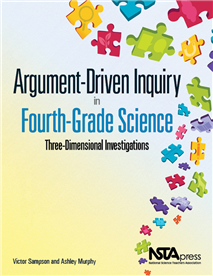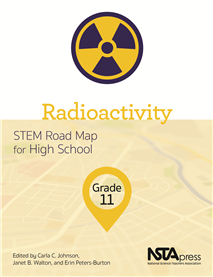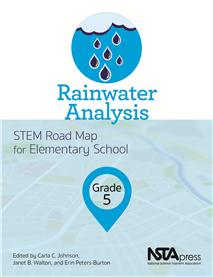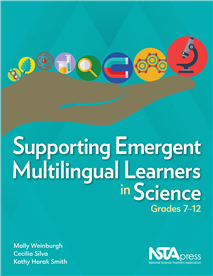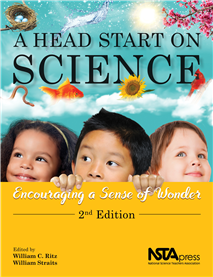All Book Chapters
Book Chapter
The guiding question of this investigation is, Why can we see the roots of trees that grow near rivers or streams? Roots of trees are usually underground. In this lesson, the goal is to figure out why trees that grow near rivers or streams often hav...
Book Chapter
The guiding question of this investigation is, Why do large waves often block the entrance to some harbors in New Zealand? In this lesson, the goal is to figure out how nautical charts can be used to locate different land and water features on Eart...
Book Chapter
This lesson provides a basic introduction to nuclear chemistry and exponential functions. Students learn about the discovery and history of radioactive elements and the scientific and societal implications of these discoveries. They model natural rad...
Book Chapter
In this lesson, students explore the process of nuclear fission from historical, scientific, and environmental perspectives. They focus on how nuclear fission is used in pressurized water reactors (PWRs), the type of nuclear reactors most commonly us...
Book Chapter
Nuclear Fusion: Harnessing the Power of the Stars
In this lesson, students consider nuclear fusion and its potential to meet human energy needs in the future, as well as the substantial technology and engineering challenges associated with creating fusion reactions. They compare and contrast the pro...
Book Chapter
In this lesson, students continue their consideration of nuclear fission and its practical application in power plants by examining the events leading to the 1979 Three Mile Island (TMI) nuclear accident and the response. They analyze a multidiscipli...
Book Chapter
The Gammatown Crisis Challenge
In this lesson, students synthesize their learning from the previous lessons to address the module’s culminating challenge—the Gammatown Crisis Challenge. Student teams are each challenged to assume the role of one of several stakeholder groups t...
Book Chapter
This lesson introduces students to the module challenge—the Rainwater Roundup Challenge. Through a slideshow and water activity, students learn about water as a scarce natural resource. As a foundation for understanding the relationship between sta...
Book Chapter
In this lesson, students continue to explore rainwater by examining the interconnectedness of Earth’s spheres. Students investigate water handling features at home and in school while conducting surveys. They learn about the need to improvise to bu...
Book Chapter
In this lesson, students continue to address the Rainwater Roundup Challenge as they determine the best shape and dimensions for a storage container for rainwater collection. Students compare their rain gauge data with rainfall data from previous yea...
Book Chapter
The Rainwater Roundup Challenge
This lesson begins with a student email to the teacher for the class bringing to their attention a big problem with the rainwater-recycling project—gravity! Students are challenged to help create solutions for this problem. To move forward with the...
Book Chapter
The Hybrid Language of the Science Classroom
In this chapter, ways are discussed in which language serves different social purposes. We highlight the social language of science as a unique hybrid that includes four modes—natural language, mathematical expressions, visual representations, and ...
Book Chapter
Inquiry-Based Science as a Context for Communication
In this chapter, ways are examined in which you can make use of science inquiry lessons to support the development of the multimodal language of science. We focus on science as a context for language learning and explore inquiry practices of science....
Book Chapter
The 5R Instructional Model for Science Instruction for Emerging Multilinguals
In our effort to support inquiry-based lessons and hybrid language learning, we developed the 5R Instructional Model. This chapter outlines the Model in general terms, and envisions it as an instructional tool for designing lessons that provide scaff...
Book Chapter
In this chapter, replace is discussed as one component of the 5R Instructional Model. Replacing serves to facilitate the development of more precise ways of meaning-making using the hybrid language of science. Replacements mostly involve a one-to-o...
Book Chapter
In this chapter, reveal is introduced as one component of the 5R Instructional Model. A critical aspect of this “R” is that it supports Emergent Multilingual Learners (EMLs) as they develop language for new concepts using the four modes of the ...
Book Chapter
In this chapter, the role of repeat is examined within the 5R Instructional Model. Repetition is used to provide Emergent Multilingual Learners (EMLs) with multiple opportunities to encounter and express scientific meaning using all of the modes of...
Book Chapter
In this chapter, reposition is introduced as a component of the five Rs.The critical aspect of repositioning is to provide Emergent Multilingual Learners (EMLs) with extended opportunities to assume the complexities of the hybrid language. Reposit...
Book Chapter
In this chapter, the “R” of reload is discussed. The critical aspect of reloading is that it provides Emergent Multilingual Learners (EMLs) with opportunities to revisit words they have previously encountered within a lesson. Reload differs from...
Book Chapter
This chapter brings the work full circle. We provide the voices of teachers who have used the 5R Instructional Model as a tool in developing their own science lessons. Thinking of this model as an overlay when using the learning cycle, these teachers...
Book Chapter
This activity focuses on using magnifiers to look closely at objects. Encourage students to use them in any part of the classroom or outdoors to help in their investigation. Magnifiers should always be kept in the science center as a reminder that it...
Book Chapter
This activity focuses on students looking at their skin, fingernails, hair, and clothes through a magnifier. Give each student a magnifier and ask them to look at their hands through the lens. Listen to their comments to see what they are discovering...
Book Chapter
This activity is about discovering that sunlight shining through a prism produces rainbow colors. Prisms work best in natural light so ask students to place pieces of white paper on the ground and show them how to hold their prisms so that the sunlig...
Book Chapter
This Color Walk activity is to look for objects in the environment that are a particular color. Green is chosen here but other colors may work well too, depending on the season and your location. Pictures may be taken or ask students to draw what th...
Book Chapter
This Shape Walk activity is to look for objects in the environment that are a particular shape. It’s best to choose a shape that will be found often in your environment. A square is a good one to start with, as it is among the most common and one ...
Book Chapter
This activity is about discovering that our eyes need light to see and in order for something to be seen, we need light. The activity works best on a cloudy day when not much sunlight is lighting the room, but make your room as dimly lit as possible....
Book Chapter
This activity uses the sense of sight to find matching objects. Take the students outside and ask them to find some items that look the same as the ones you collected and put in their bags. Back in the classroom, ask them to look at their items with ...
Book Chapter
This activity is for observing and tasting foods that are salty, sour, sweet, or bitter. Give each student a piece of four different foods, such as tortilla chip, pineapple, pickle, and green apple. As children taste each one, encourage a conversatio...
Book Chapter
This activity is for using the sense of smell to observe and identify different scents. At the start, discuss with the students how our sense of smell is very important and can help us identify different objects. Then distribute one set of “smelly ...
Book Chapter
This activity is for sorting flowers based on their scents. Have children arrange their flowers in a Sorting Box with all the flowers that smell on one side and those that don’t on the other side. Ask them to talk more about the sense of smell, wha...
Book Chapter
Sound: Shake, Rattle, and Roll
This activity focuses on exploring, comparing, and identifying sounds. Ask children to close their eyes and focus on their sense of hearing while making different sounds and letting them guess the sound. Then give a set of clear sound containers to ...
Book Chapter
This activity takes the children on a sound walk around the school grounds or surrounding neighborhood to listen for different sounds. The children should walk without talking until they hear some sounds. Once back inside ask them to draw a picture o...
Book Chapter
This activity explores sound and vibrations using rulers. Children are asked to observe and describe how the ruler moves or “vibrates” as it makes sound. After noticing that different sounds are possible, children will change the position of thei...
Book Chapter
This activity is about reusing materials to make sounds. In the activity, children use their used cups and paper towels to make a noise maker that results in a very realistic duck sound! Children will want to continue this activity all day long. Inst...
Book Chapter
This activity focuses on identifying various materials by touch. The activity encourages children to touch and hold the various materials as they make a collage. When collages are finished, put them on tables and have children feel each collage and t...
Book Chapter
This activity uses the sense of touch to match objects. In the activity, each group of students is given a matching set of materials to observe and describe. After initial discussions, children are asked to consider how the objects feel and one set ...
Book Chapter
This activity is for observing that wind can make objects move. In the activity, children take a walk around the school grounds on a breezy day to look for things that are moving. Children are asked to describe the things they saw once back inside. ...
Book Chapter
This activity is for discovering what makes streamers move. On a breezy day, give each child a small stick with a streamer attached. Let children explore with their streamers and challenge them to walk in different directions and to hold the streamer...
Book Chapter
This activity is for testing how different speeds of wind make objects move. In the activity, students hold their streamers in front of an electric fan. By changing the speed of the fan, have the students describe and compare their streamers. A mater...
Book Chapter
This activity involves playing with a parachute to make discoveries about air. It is always a favorite activity as most children enjoy hiding under the parachute but limit the number who can hide at the same time. After they play with the parachute, ...



